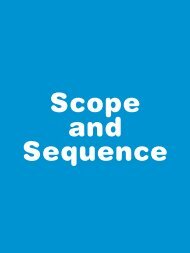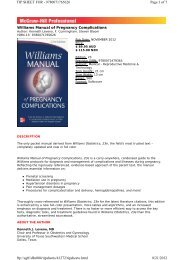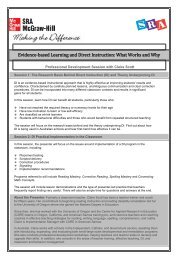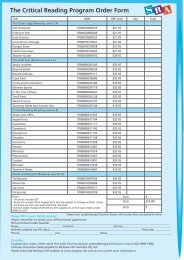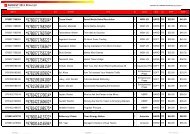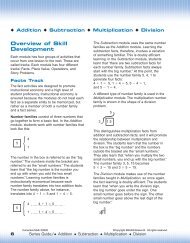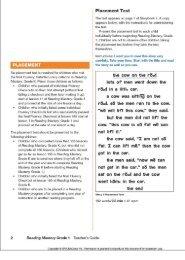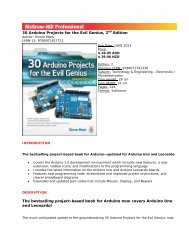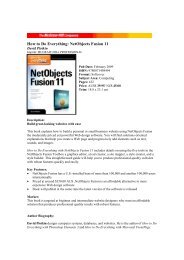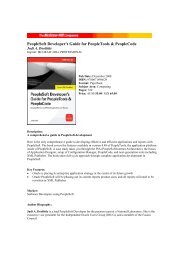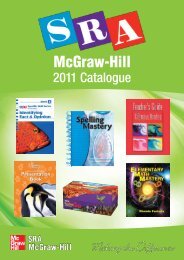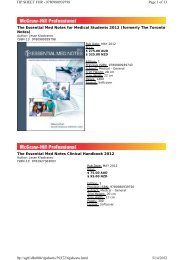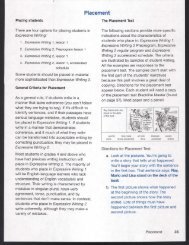advancement flap - McGraw-Hill Education Australia & New Zealand
advancement flap - McGraw-Hill Education Australia & New Zealand
advancement flap - McGraw-Hill Education Australia & New Zealand
Create successful ePaper yourself
Turn your PDF publications into a flip-book with our unique Google optimized e-Paper software.
Paver I Stanford I Storey<br />
dermatologic<br />
SURGERY<br />
a MANUAL of DEFECT REPAIR OPTIONS<br />
DVD INCLUDES 100 SURGICAL VIDEO CLIPS<br />
18mm 286mm<br />
18mm
dermatologic<br />
SURGERY<br />
a MANUAL of DEFECT REPAIR OPTIONS
Notice<br />
Medicine is an ever-changing science. As new research and clinical experience broaden our knowledge, changes in treatment and<br />
drug therapy are required. The editors and the publisher of this work have checked with sources believed to be reliable in their efforts<br />
to provide information that is complete and generally in accord with the standards accepted at the time of publication. However, in<br />
view of the possibility of human error or changes in medical sciences, neither the editors, nor the publisher, nor any other party who has<br />
been involved in the preparation or publication of this work warrants that the information contained herein is in every respect accurate<br />
or complete. Readers are encouraged to confirm the information contained herein with other sources. For example, and in particular,<br />
readers are advised to check the product information sheet included in the package of each drug they plan to administer to be certain<br />
that the information contained in this book is accurate and that changes have not been made in the recommended dose or in the<br />
contraindications for administration. This recommendation is of particular importance in connection with new or infrequently used drugs.<br />
First published 2011<br />
Copyright © 2011 <strong>McGraw</strong>-<strong>Hill</strong> <strong>Australia</strong> Pty Limited<br />
Additional owners of copyright are acknowledged in on-page credits.<br />
Every effort has been made to trace and acknowledge copyrighted material. The authors and publishers tender their apologies should<br />
any infringement have occurred.<br />
Reproduction and communication for educational purposes<br />
The <strong>Australia</strong>n Copyright Act 1968 (the Act) allows a maximum of one chapter or 10% of the pages of this work, whichever is the<br />
greater, to be reproduced and/or communicated by any educational institution for its educational purposes provided that the institution<br />
(or the body that administers it) has sent a Statutory <strong>Education</strong>al notice to Copyright Agency Limited (CAL) and been granted a licence.<br />
For details of statutory educational and other copyright licences contact: Copyright Agency Limited, Level 15, 233 Castlereagh Street,<br />
Sydney NSW 2000. Telephone: (02) 9394 7600. Website: www.copyright.com.au<br />
Reproduction and communication for other purposes<br />
Apart from any fair dealing for the purposes of study, research, criticism or review, as permitted under the Act, no part of this<br />
publication may be reproduced, distributed or transmitted in any form or by any means, or stored in a database or retrieval system,<br />
without the written permission of <strong>McGraw</strong>-<strong>Hill</strong> <strong>Australia</strong> including, but not limited to, any network or other electronic storage.<br />
Enquiries should be made to the publisher via www.mcgraw-hill.com.au or marked for the attention of the permissions editor at the<br />
address below.<br />
National Library of <strong>Australia</strong> Cataloguing-in-Publication Data<br />
Author:<br />
Paver, Rob.<br />
Title: Dermatologic surgery: a manual of defect repair options /<br />
Rob Paver, Duncan Stanford, Leslie Storey.<br />
ISBN:<br />
9780070285392 (hbk.)<br />
Notes:<br />
Includes index. Bibliography.<br />
Subjects:<br />
skin-surgery, surgery, plastic <strong>flap</strong>s (surgery)<br />
Other Authors/Contributors: Stanford, Duncan, Storey, Leslie.<br />
Dewey Number: 617.477<br />
Published in <strong>Australia</strong> by<br />
<strong>McGraw</strong>-<strong>Hill</strong> <strong>Australia</strong> Pty Ltd<br />
Level 2, 82 Waterloo Road, North Ryde NSW 2113<br />
Publisher: Elizabeth Walton<br />
Associate editor: Fiona Richardson<br />
Art director: Astred Hicks<br />
Cover design: Patricia McCallum<br />
Internal design: Astred Hicks and Patricia McCallum<br />
Production editor: Michael McGrath<br />
Copy editor: Marcia Bascombe<br />
Illustrator: Chris Welch<br />
Proofreader: Terence Townsend<br />
Indexer: Shelley Barons<br />
CD-ROM preparation:<br />
CD-ROM cover and manual design:<br />
Typeset in … by Midland Typesetters<br />
Printed in China on 105 gsm by iBook Printing Ltd.
Robert Paver<br />
Duncan Stanford<br />
Leslie Storey<br />
dermatologic<br />
SURGERY<br />
a MANUAL of DEFECT REPAIR OPTIONS
v<br />
FOREWORD<br />
Over recent decades, Dermatologic Surgery has<br />
witnessed tremendous growth and evolution. Expansion of<br />
both established procedures, as well as the development<br />
of new surgical techniques, has led to the division of<br />
Dermatologic Surgery into two separate disciplines: Mohs<br />
Micrographic Surgery/Surgical Repair and Cosmetic<br />
Surgery.<br />
This text addresses the former; the repair of surgical<br />
defects created by the eradication of skin cancers. Every<br />
year thousands of Mohs procedures are performed across<br />
the globe, producing their resultant defects. Dermatologic<br />
Surgery: a manual of defect repair options is organized<br />
into two complementary sections; a textbook format<br />
and corresponding videos. Numerous other texts have<br />
organized these topics in a similar manner to the written<br />
text material presented here. What makes this project<br />
unique is supplementing the standard textbook format<br />
with an extensive, comprehensive collection of videos<br />
that correspond to the surgical procedures. Cutting-edge<br />
teaching methods have finally caught up with present-day<br />
technology. By being invited into the operating room,<br />
students at all levels are treated to a stunning personal<br />
perspective. The experience is like having your own<br />
private expert mentor.<br />
The overriding concept here is to perform defect repairs<br />
employing principles developed for the cosmetic-subunit<br />
paradigm. These include: if possible, limiting repairs to<br />
one cosmetic unit; placing scar lines in junction lines<br />
dividing cosmetic units or the adjoining relaxed skin<br />
tension lines and, if most of a cosmetic unit is missing,<br />
excising the remainder and repairing the whole unit.<br />
To actually see the application of these principles<br />
unfold on screen is a true learning experience. The videos<br />
in particular reveal those aspects of the procedure not<br />
readily demonstrated with static two-dimensional pictures.<br />
These include: <strong>flap</strong> design and execution, the tension<br />
vector of closure, the effect of the tension vector on free<br />
margins, how to hold instruments, how to handle tissue<br />
gently, the extent and level of undermining, final trimming<br />
of tissue before closure and the utility of an assistant. The<br />
procedures range in difficulty from simple to complicated.<br />
The videos are edited to show only the important stages<br />
of the repair and avoid time-consuming repetition. Each<br />
type of <strong>flap</strong> is covered, although not each <strong>flap</strong> within<br />
every cosmetic unit is presented, thus avoiding needless<br />
repetition.<br />
Dermatologic Surgery: a manual of defect repair options<br />
represents tremendous innovation and a step forward in<br />
surgical education. The videos show a time sequence<br />
dynamic that is difficult to achieve in any other format.<br />
Certainly, videos of surgical procedures have been used as<br />
teaching tools before. Their use, however, has been mostly<br />
limited to individual case presentations at professional<br />
meetings or personal libraries available only to local<br />
registrars. Now they are available to a more general<br />
audience of students of all levels. Whether novice or<br />
experienced practitioner, whether trained in dermatology,<br />
plastic surgery, or head and neck surgery, everyone will<br />
find something to add to their surgical armamentarium.<br />
The accompanying text is organized in a template<br />
manner. Each cosmetic unit section is introduced with<br />
a description of the properties of the skin in that unit<br />
as well as the scope of repair options. Individual<br />
repairs are illustrated by photographs, line drawings.<br />
The accompanying text describes the procedure, its<br />
advantages disadvantages and caveats, as well as<br />
stressing the take-home main points. Another benefit is<br />
that long-term outcomes conclude each picture series. The<br />
reader will become comfortable with this repetitive format.<br />
Cases with accompanying videos are clearly identified<br />
with an appropriate symbol.<br />
Surgeons often become proficient with one or two <strong>flap</strong><br />
techniques and try to apply them to all defects. From<br />
Dermatologic Surgery: a manual of defect repair options<br />
they will gain a different perspective that may better suit<br />
the defect and, in the long run, the patient.<br />
The authors should be congratulated for sharing their<br />
expertise. The forethought and time spent to tape and edit<br />
this wide range of reconstructive procedures reveals the<br />
heart of a true teacher/educator. Theirs is a contribution<br />
of significant importance. The initial and prime audience<br />
is noted to be registrars in training. There is not any<br />
doubt that this will reach and benefit a wider audience.<br />
My advice; read the text and view the videos over and<br />
over again. You will be treated to nuances you didn’t<br />
appreciate before.<br />
Stuart J Salasche, MD
vii<br />
CONTENTS IN BRIEF<br />
Foreword<br />
Preface<br />
About the authors<br />
Acknowledgments<br />
v<br />
xiv<br />
xvii<br />
xviii<br />
SECTION 1 – NOSE 1<br />
Chapter 1 Nasal Tip 2<br />
Chapter 2 Nasal Ala 28<br />
Chapter 3 Nasal Dorsum 56<br />
Chapter 4 Nasal Sidewall 70<br />
Chapter 5 Nasal Root 82<br />
SECTION 2 – FOREHEAD AND TEMPLE 90<br />
Chapter 6 Central Forehead 92<br />
Chapter 7 Lateral Forehead 104<br />
Chapter 8 Eyebrow and Suprabrow 116<br />
Chapter 9 Temple 126<br />
SECTION 3 – PERIORAL 140<br />
Chapter 10 Lateral Upper Lip and Perialar<br />
Region 142<br />
Chapter 11 Central Upper Lip 160<br />
Chapter 12 Vermilion Upper Lip 172<br />
Chapter 13 Lateral Lower Lip 178<br />
Chapter 14 Central Lower Lip 188<br />
Chapter 15 Vermilion Lower Lip 194<br />
Chapter 16 Chin 202<br />
SECTION 4 – CHEEKS 208<br />
Chapter 17 Medial Cheek 211<br />
Chapter 18 Central Cheek 220<br />
Chapter 19 Preauricular 230<br />
Chapter 20 Mandibular 238<br />
SECTION 5 – EARS 242<br />
Chapter 21 Upper-third of the Helical Rim 244<br />
Chapter 22 Middle-third of the Helical Rim 254<br />
Chapter 23 Conchal Bowl and External<br />
Auditory Canal 264<br />
Chapter 24 Anterior Ear 270<br />
Chapter 25 Posterior Ear 282<br />
Chapter 26 Ear Lobe 292<br />
SECTION 6 – PERIOCCULAR 296<br />
Chapter 27 Lateral Canthus 299<br />
Chapter 28 Lower Eyelid 306<br />
Chapter 29 Medial Canthus 320<br />
Chapter 30 Upper Eyelid 332<br />
SECTION 7 – SCALP 340<br />
Chapter 31 Scalp 342<br />
SECTION 8 – NECK AND MASTOID 354<br />
Chapter 32 Neck 356<br />
Chapter 33 Mastoid 364<br />
SECTION 9 – TRUNK AND LIMBS 372<br />
Chapter 34 Trunk and Limbs 374<br />
Index 388
viii<br />
CONTENTS IN FULL<br />
Foreword<br />
Preface<br />
About the authors<br />
Acknowledgment s<br />
v<br />
xiv<br />
xvii<br />
xviii<br />
SECTION 1 NOSE 1<br />
CHAPTER 1 NASAL TIP 2<br />
• Side-to-side closure 4<br />
• Burow’s exchange <strong>advancement</strong> <strong>flap</strong> 6<br />
• Bilobed <strong>flap</strong> (Zitelli variation)<br />
7<br />
• Dorsal nasal rotation <strong>flap</strong><br />
10<br />
• Myocutaneous <strong>flap</strong>s<br />
12<br />
• Unilateral pedicle technique 13<br />
• Horn variation 14<br />
• Bilateral pedicle variation technique 15<br />
• Hunt variation 16<br />
• Rhombic transposition <strong>flap</strong> 17<br />
• Subcutaneous island pedicle <strong>flap</strong> 18<br />
• Double-rotation <strong>flap</strong> (Peng variant) 19<br />
• Two-stage interpolation <strong>flap</strong> 20<br />
• Two-stage paramedian forehead interpolation <strong>flap</strong> 20<br />
• Two-stage nasolabial interpolation <strong>flap</strong> 23<br />
• Full-thickness skin graft 25<br />
CHAPTER 2 NASAL ALA 28<br />
Nasal Ala Repairs for Partial Thickness Defects<br />
• Side-to-side closure 29<br />
• Bilobed transposition <strong>flap</strong> (medially or<br />
laterally based) 30<br />
• Nasolabial transposition <strong>flap</strong> (Zitelli variation) 32<br />
• Subcutaneous island pedicle <strong>flap</strong> 34<br />
• Rhombic transposition <strong>flap</strong> 35<br />
• Myocutaneous island pedicle <strong>flap</strong> 36<br />
• Transposed island pedicle <strong>flap</strong> 37<br />
• Shark island pedicle <strong>flap</strong> 38<br />
• Two-stage nasolabial interpolation <strong>flap</strong> 40<br />
• Full-thickness skin graft 42<br />
• Second intention 44<br />
xx<br />
• Composite graft 45<br />
• Nasolabial turnover island pedicle <strong>flap</strong> (spear <strong>flap</strong>) 47<br />
• Tunnelled (Kearney) variant of the nasolabial<br />
turnover island pedicle <strong>flap</strong> 50<br />
• Combined procedure—mucosa, cartilage, and skin 51<br />
• Mucosal layer 51<br />
• Cartilage layer 52<br />
• Skin 55<br />
CHAPTER 3 NASAL DORSUM 56<br />
• Side-to-side closure 58<br />
• Perialar Burow’s exchange <strong>advancement</strong> <strong>flap</strong> 59<br />
• Subcutaneous island pedicle <strong>flap</strong><br />
60<br />
• Back-cut rotation <strong>flap</strong><br />
62<br />
• Bilateral single-sided <strong>advancement</strong> (T-plasty or A-T) <strong>flap</strong> 63<br />
• Double-rotation <strong>flap</strong> (Peng variant) 64<br />
• Rhombic transposition <strong>flap</strong> 65<br />
• Bilobed transposition <strong>flap</strong> 66<br />
• Transposed island pedicle <strong>flap</strong> 67<br />
• Myocutaneous <strong>flap</strong> (refer to Chapter 1 Nasal tip) 68<br />
• Full-thickness skin graft (refer to Chapter 1 Nasal tip) 69<br />
CHAPTER 4 NASAL SIDEWALL 70<br />
• Side-to-side closure 72<br />
• Advancement <strong>flap</strong>s 73<br />
• Perialar Burow’s exchange <strong>advancement</strong> <strong>flap</strong> 73<br />
• Nasolabial <strong>advancement</strong> <strong>flap</strong> 74<br />
• Back-cut rotation <strong>flap</strong><br />
75<br />
• Subcutaneous island pedicle <strong>flap</strong><br />
76<br />
• Transposition <strong>flap</strong>s 77<br />
• Bilobed transposition <strong>flap</strong> 77<br />
• Nasolabial transposition <strong>flap</strong> 78<br />
• Rhombic transposition <strong>flap</strong> 79<br />
• Cheek <strong>advancement</strong> with Burow’s graft 80<br />
• Full-thickness skin graft 81
Contents<br />
ix<br />
CHAPTER 5 NASAL ROOT 82<br />
• Side-to-side closure 84<br />
• Rhombic transposition <strong>flap</strong><br />
85<br />
• Back-cut rotation <strong>flap</strong><br />
86<br />
• Subcutaneous island pedicle <strong>flap</strong> 87<br />
• Procerus myocutaneous <strong>flap</strong> 88<br />
• Side-to-side closure with a V-to-Y <strong>advancement</strong><br />
from the glabella 89<br />
SECTION 2 FOREHEAD AND TEMPLE 90<br />
CHAPTER 6 CENTRAL FOREHEAD 92<br />
• Side-to-side (vertical) closure<br />
94<br />
• Advancement <strong>flap</strong>s 95<br />
• Unilateral single-sided <strong>advancement</strong> <strong>flap</strong> (O-to-L) 95<br />
• Bilateral single-sided <strong>advancement</strong> <strong>flap</strong> (O-to-T)<br />
T-plasty 96<br />
• Bilateral two-sided <strong>advancement</strong> <strong>flap</strong> (O-to-H) 97<br />
• Rotation <strong>flap</strong> 98<br />
• Subcutaneous island pedicle <strong>flap</strong> 99<br />
• Skin grafts 100<br />
• Partial closure plus Burow’s graft 100<br />
• Partial closure plus second intention 101<br />
CHAPTER 7 LATERAL FOREHEAD 104<br />
• Side-to-side closure 106<br />
• Advancement <strong>flap</strong>s 107<br />
• Unilateral single-sided <strong>advancement</strong> <strong>flap</strong> (O-to-L)<br />
and Burow’s exchange <strong>advancement</strong> 107<br />
• Bilateral single-sided <strong>advancement</strong><br />
<strong>flap</strong> (O-to-T) 108<br />
• Bilateral two-sided <strong>advancement</strong> <strong>flap</strong> (O-to-H) 109<br />
• Rotation <strong>flap</strong> 110<br />
• Rhombic transposition <strong>flap</strong> 111<br />
• Skin grafts 112<br />
• Full-thickness skin graft 112<br />
• Burow’s full-thickness skin graft 113<br />
• Split-thickness skin graft 114<br />
CHAPTER 8 EYEBROW AND SUPRABROW 116<br />
• Side-to-side (horizontal or vertical) closure 118<br />
• Advancement <strong>flap</strong>s 119<br />
• Unilateral single-sided <strong>advancement</strong><br />
<strong>flap</strong> (O-to-L) 119<br />
• Bilateral single-sided <strong>advancement</strong><br />
<strong>flap</strong> (O-to-T) 120<br />
• Unilateral or bilateral two-sided <strong>advancement</strong><br />
<strong>flap</strong> (O-to-U or O-to-H) 121<br />
• Subcutaneous island pedicle <strong>flap</strong><br />
123<br />
• Full-thickness skin graft for the suprabrow 124<br />
Legend<br />
Preferred option when a standard side-to-side closure is not possible<br />
Sometimes a side-to-side closure can still be used for a medium to large defect
x DERMATOLOGIC SURGERY A manual of defect repair options<br />
CONTENTS IN FULL<br />
CHAPTER 9 TEMPLE<br />
xx<br />
CHAPTER 11 CENTRAL UPPER LIP<br />
xx<br />
• Side-to-side closure 128<br />
• Rhombic transposition <strong>flap</strong><br />
130<br />
• Rotation <strong>flap</strong> 132<br />
• Advancement <strong>flap</strong>s 133<br />
• Burow’s exchange <strong>advancement</strong> <strong>flap</strong><br />
133<br />
• Tripolar (Mercedes) <strong>advancement</strong> <strong>flap</strong> 134<br />
• Unilateral two-sided <strong>advancement</strong> <strong>flap</strong><br />
(o-to-U <strong>flap</strong>) 135<br />
• Skin grafts 136<br />
• Partial closure plus Burow’s full-thickness skin graft 136<br />
• Full-thickness skin graft 137<br />
• Split-thickness skin graft 137<br />
• Second intention 138<br />
SECTION 3 PERIORAL 140<br />
CHAPTER 10 LATERAL UPPER LIP AND<br />
PERIALAR REGION 142<br />
• Side-to-side closure<br />
144<br />
• Wedge excision 146<br />
• Rotation <strong>flap</strong><br />
148<br />
• Advancement <strong>flap</strong>s 150<br />
• Burow’s exchange <strong>advancement</strong> <strong>flap</strong> 150<br />
• Double <strong>advancement</strong> (T-plasty or O-T) <strong>flap</strong> 151<br />
• Crescentic <strong>advancement</strong> <strong>flap</strong>s 153<br />
• Crescentic <strong>advancement</strong> with Burow’s triangle<br />
in lip rhytides 153<br />
• Crescentic <strong>advancement</strong> with muscle and<br />
mucosal wedge 154<br />
• Crescentic <strong>advancement</strong> utilizing a horizontal cut 155<br />
• along vermilion border 155<br />
• Rotation <strong>flap</strong> combined with wedge excision 156<br />
• Transposition <strong>flap</strong> 157<br />
• Subcutaneous island pedicle <strong>flap</strong> 158<br />
• Vertical Side-to-side closure 162<br />
• Wedge excision 162<br />
• Advancement <strong>flap</strong>s 163<br />
• Uuilateral, single-sided, (crescentic)<br />
<strong>advancement</strong> <strong>flap</strong> 163<br />
• Bilateral, single-sided, <strong>advancement</strong><br />
(T-plasty or O-T) <strong>flap</strong> 164<br />
• Bilateral, single-sided, <strong>advancement</strong> (T-plasty<br />
or O-T) <strong>flap</strong> with a full-thickness wedge 164<br />
• Unilateral, two-sided <strong>advancement</strong> <strong>flap</strong> 165<br />
• Bilateral, two-sided <strong>advancement</strong> <strong>flap</strong> 166<br />
• Philtral defects 167<br />
• Side-to-side closure 167<br />
• Advancement <strong>flap</strong> (T-plasty) 167<br />
• Advancement <strong>flap</strong> (philtral two-sided) 168<br />
• Subcutaneous island pedicle <strong>flap</strong> 169<br />
• Full-thickness skin graft 170<br />
CHAPTER 12 VERMILION UPPER LIP 172<br />
• Wedge excision<br />
174<br />
• Mucosal <strong>advancement</strong> <strong>flap</strong> 175<br />
• Bilateral vermilion rotation <strong>flap</strong> 176<br />
• Mucosal V-to-Y island pedicle <strong>flap</strong> 177<br />
CHAPTER 13 LATERAL LOWER LIP<br />
• Wedge excision<br />
182<br />
• Burow’s exchange <strong>advancement</strong> <strong>flap</strong><br />
185<br />
• Rotation <strong>flap</strong> 186<br />
• Subcutaneous island pedicle <strong>flap</strong> 187<br />
CHAPTER 14 CENTRAL LOWER LIP 188<br />
• Wedge excision 190<br />
• Bilateral two-sided <strong>advancement</strong> <strong>flap</strong><br />
192<br />
xx
Contents<br />
xi<br />
CHAPTER 15 VERMILION LOWER LIP 194<br />
CHAPTER 19 PREAURICULAR<br />
xx<br />
• Side-to-side closure 196<br />
• Mucosal <strong>advancement</strong> <strong>flap</strong> (surgical vermilionectomy)<br />
•<br />
196<br />
Bilateral vermilion rotation <strong>flap</strong> 198<br />
• Mucosal V-to-Y island pedicle <strong>flap</strong> 200<br />
• Wedge excision 200<br />
CHAPTER 16 CHIN 202<br />
• Side-to-side closure 204<br />
• Single- or double-rotation <strong>flap</strong>s 205<br />
• Rhombic transposition <strong>flap</strong> 207<br />
SECTION 4 CHEEK 208<br />
CHAPTER 17 MEDIAL CHEEK 211<br />
• Side-to-side closure 212<br />
• Nasolabial <strong>advancement</strong> <strong>flap</strong> 213<br />
• Rotation <strong>flap</strong> 215<br />
• Subcutaneous island pedicle <strong>flap</strong> 217<br />
CHAPTER 18 CENTRAL CHEEK 220<br />
• Side-to-side closure 222<br />
• Advancement <strong>flap</strong> 223<br />
• Rotation <strong>flap</strong> 224<br />
• Subcutaneous island pedicle 225<br />
• Rotating Lenticular subcutaneous island<br />
pedicle <strong>flap</strong> 226<br />
• Rhombic transposition <strong>flap</strong> 228<br />
• Side-to-side closure 232<br />
• Burow’s exchange <strong>advancement</strong> <strong>flap</strong> 233<br />
• Subcutaneous island pedicle <strong>flap</strong> 234<br />
• Rhombic transposition <strong>flap</strong> 235<br />
• Skin grafts 236<br />
• Combined <strong>flap</strong> and Burow’s full-thickness<br />
skin graft 236<br />
• Split-thickness skin graft 237<br />
CHAPTER 20 MANDIBLE 238<br />
• Side-to-side closure 240<br />
• Rhombic transposition <strong>flap</strong><br />
241<br />
SECTION 5 EARS 242<br />
CHAPTER 21 UPPER-THIRD OF THE<br />
HELICAL RIM 244<br />
• Side-to-side closure 246<br />
• Wedge excision 247<br />
• ‘Banner’ Transposition <strong>flap</strong> 248<br />
• Superior helical rim <strong>advancement</strong> <strong>flap</strong> 250<br />
• Bilobed transposition <strong>flap</strong> 251<br />
• Helical crus rotation <strong>flap</strong> 252<br />
• Full-thickness skin graft 253
xii DERMATOLOGIC SURGERY A manual of defect repair options<br />
CONTENTS IN FULL<br />
CHAPTER 22<br />
MIDDLE-THIRD OF THE<br />
HELICAL RIM 254<br />
• Side-to-side closure 256<br />
• Wedge excision 256<br />
• Helical rim <strong>advancement</strong> <strong>flap</strong> 258<br />
• Helical rim <strong>advancement</strong> <strong>flap</strong><br />
(partial-thickness variant) 260<br />
• Full-thickness skin graft 261<br />
• Two-stage postauricular pedicle interpolation <strong>flap</strong> 262<br />
CHAPTER 23 CONCHA BOWL<br />
AND EXTERNAL<br />
AUDITORY CANAL 264<br />
• Full-thickness skin fraft 266<br />
• Pull-through <strong>flap</strong> 267<br />
• Split-thickness skin graft 268<br />
• Second intention 269<br />
CHAPTER 24 ANTERIOR EAR 270<br />
• Side-to-side closure 272<br />
• Rotation <strong>flap</strong> 274<br />
• Full-thickness skin graft<br />
276<br />
• Pull-through <strong>flap</strong><br />
277<br />
• Transposition <strong>flap</strong> 278<br />
• Split-thickness skin graft 279<br />
• Second intention 280<br />
CHAPTER 25 POSTERIOR EAR 282<br />
• Side-to-side closure 284<br />
• Rotation <strong>flap</strong><br />
285<br />
• Transposition <strong>flap</strong>s 286<br />
• Rhombic transposition <strong>flap</strong><br />
286<br />
• Bilobed <strong>flap</strong><br />
287<br />
• Burow’s exchange <strong>advancement</strong> <strong>flap</strong> 288<br />
• Full-thickness skin graft 289<br />
• Split-thickness skin graft 290<br />
• Second intention healing 291<br />
CHAPTER 26 EAR LOBE 292<br />
• Side-to-side closure 294<br />
• Wedge excision<br />
294<br />
• Transposition <strong>flap</strong>—one or two stage 295<br />
SECTION 6 PERIOCULAR 296<br />
CHAPTER 27 LATERAL CANTHUS 300<br />
• Side-to-side closure 300<br />
• Rhombic transposition <strong>flap</strong><br />
301<br />
• Advancement <strong>flap</strong> 302<br />
• Rotation <strong>flap</strong> 302<br />
• Bilobed <strong>flap</strong> 303<br />
• Full-thickness skin graft 304<br />
CHAPTER 28 LOWER EYELID 306<br />
• Side-to-side closure 308<br />
• Wedge excision<br />
309<br />
• Advancement <strong>flap</strong><br />
311<br />
• Rotation <strong>flap</strong> 312<br />
• ‘Banner’ Transposition <strong>flap</strong> from the upper eyelid 313<br />
• Rhombic transposition <strong>flap</strong> 314<br />
• Subcutaneous island pedicle <strong>flap</strong> 316<br />
• Full-thickness skin graft 317<br />
CHAPTER 29 MEDIAL CANTHUS 320<br />
• Side-to-side closure 322<br />
• Transposition <strong>flap</strong><br />
323<br />
• Subcutaneous island pedicle <strong>flap</strong> 324<br />
• Procerus myocutaneous <strong>flap</strong><br />
325<br />
• glabella back-cut rotation <strong>flap</strong> 326
Contents<br />
xiii<br />
• Full-thickness skin graft 327<br />
• Split-thickness skin graft 328<br />
• Second intention healing 330<br />
• Z-Plasty repair 331<br />
CHAPTER 30 UPPER EYELID 332<br />
• Side-to-side (horizontal) closure 334<br />
• Subcutaneous island pedicle <strong>flap</strong><br />
335<br />
• Wedge excision 336<br />
• Advancement <strong>flap</strong> 337<br />
• Rotation <strong>flap</strong> 337<br />
• Full-thickness skin graft 338<br />
SECTION 7 SCALP 340<br />
CHAPTER 31 SCALP 342<br />
• Side-to-side closure 344<br />
• Single and double rotation <strong>flap</strong>s<br />
346<br />
• Full-thickness skin graft 348<br />
• Split-thickness skin graft 349<br />
• Purse-string closure 350<br />
• Variations of second intention healing 351<br />
• Second intention healing 351<br />
• Large <strong>flap</strong>s with split-thickness graft to the<br />
secondary defect 352<br />
SECTION 8 NECK AND MASTOID 354<br />
CHAPTER 32 NECK<br />
• Side-to-side closure<br />
358<br />
• Bilateral single-sided <strong>advancement</strong><br />
(T-plasty or O-T) <strong>flap</strong> 360<br />
• Transposition <strong>flap</strong>s 361<br />
• Rhombic transposition <strong>flap</strong> 361<br />
• Bilobed transposition <strong>flap</strong> 362<br />
• skin grafts 362<br />
CHAPTER 33 MASTOID 364<br />
• Side-to-side closure 366<br />
• Rotation <strong>flap</strong><br />
367<br />
• Transposition <strong>flap</strong> 368<br />
• Unilateral or bilateral single-sided <strong>advancement</strong> <strong>flap</strong><br />
(Burow’s exchange <strong>advancement</strong> <strong>flap</strong> and T-plasty) 369<br />
• Full-thickness skin graft including Burow’s graft 370<br />
• Split-thickness skin graft 371<br />
SECTION 9 TRUNK AND LIMBS 372<br />
CHAPTER 34 TRUNK AND LIMBS 374<br />
• Side-to-side closure<br />
376<br />
• Tripolar (Mercedes) <strong>advancement</strong> <strong>flap</strong><br />
379<br />
• Rotation <strong>flap</strong><br />
380<br />
• Rhombic transposition <strong>flap</strong><br />
381<br />
• Subcutaneous island pedicle <strong>flap</strong> 382<br />
• Keystone island pedicle <strong>flap</strong> 383<br />
• Side-to-side OR FLAP closure with a Burow’s graft 385<br />
• Split-thickness skin graft 386<br />
xx
xiv DERMATOLOGIC SURGERY A manual of defect repair options<br />
PREFACE<br />
THE AIM<br />
This book is a practical, “how-to-do-it” manual of<br />
cutaneous defect repair options in dermatologic<br />
surgery. We have compiled all of the repairs that we<br />
find useful and that lead to consistently good results,<br />
and presented them in a logical, consistent format<br />
supported by extensive use of diagrams and<br />
photographs. This is supplemented by a DVD which<br />
closely simulates looking over the shoulder of an<br />
experienced mentor, which we believe is one of the<br />
best ways to learn dermatologic surgery.<br />
While this manual is comprehensive in scope, it<br />
does not attempt to cover every repair possible at<br />
every site. Certain repairs have not been included as<br />
they are either not performed by the authors or are<br />
thought to be inferior to the options we do provide. The<br />
repairs featured in the various sections of the manual<br />
reflect the experiences of the surgeons at the Skin &<br />
Cancer Foundation <strong>Australia</strong> (Westmead). The nose, for<br />
example, is the most common site and one of the most<br />
challenging we operate on. As a result the nose has an<br />
extensive section in this manual, whereas the periocular<br />
region is a less common site and has a much smaller<br />
section. Many of the more difficult periocular defects are<br />
repaired by our visiting oculoplastic surgeons but we<br />
have limited our discussion to repairs we consider within<br />
the skill of the typical dermatologic surgeon.<br />
This manual assumes the reader already has basic<br />
skills in cutaneous surgery. The book is not a complete<br />
guide to surgery, and basic aspects of surgery, such<br />
as local anesthesia, instrumentation, suturing, skin<br />
physiology, preoperative assessment, postoperative care,<br />
and management of complications, are not included.<br />
THE TARGET AUDIENCE<br />
The manual is primarily aimed at dermatologic surgeons<br />
with good surgical skills who wish to expand their<br />
knowledge of repair options to allow closure of more<br />
difficult defects. However, it also, provides something for<br />
novices looking to extend their skills as well as for the<br />
expert preparing a teaching session. While the authors<br />
are dermatologists, we hope that any practitioner treating<br />
skin cancer, as well as trainees wishing to learn, will find<br />
the manual a useful resource.<br />
NECK 1%<br />
TRUNK AND LIMBS 2%<br />
SCALP 3%<br />
PERIORAL AREA 6%<br />
NOSE 41%<br />
BCC 92%<br />
CHEEK 9%<br />
RARER TUMORS 1%<br />
e.g. MAC, AFX etc.<br />
SCC 7%<br />
EARS 10%<br />
PERIOCULAR AREA 13%<br />
FOREHEAD &<br />
TEMPLE 15%<br />
MOHS CASES AT THE SKIN & CANCER FOUNDATION<br />
AUSTRALIA, 2007 BY ANATOMICAL SITE<br />
MOHS CASES AT THE SKIN & CANCER FOUNDATION<br />
AUSTRALIA, 2007 BY HISTOLOGICAL TYPE
Preface xv<br />
THE MANUAL’S FORMAT<br />
The manual is divided into nine sections representing<br />
the various body regions—eight for head and neck, and<br />
one for trunk and limbs. The head and neck sections are<br />
further subdivided into chapters representing the cosmetic<br />
subunits within each region. Each chapter starts with<br />
an overview and a list of the common repair options<br />
for that region or subunit. Next, each repair option is<br />
discussed by listing the advantages and disadvantages,<br />
followed by a stepwise description of the technique<br />
for each procedure. Practical tips are highlighted and<br />
risks and complications are mentioned where relevant.<br />
Some repetition is deliberate so that the reader is not<br />
constantly turning pages to previous sections.<br />
The book is extensively illustrated with photos and<br />
diagrams, and the accompanying DVD includes over<br />
100 video demonstrations with commentary, providing a<br />
“bird’s eye view” of the key points of the operation. These<br />
are clearly referenced in the text.<br />
THE SKIN & CANCER FOUNDATION<br />
AUSTRALIA (WESTMEAD)<br />
The Skin & Cancer Foundation <strong>Australia</strong> (SCFA) is a<br />
specialized medical organization dedicated to providing<br />
high-quality services in the areas of dermatology and<br />
dermatopathology. The foundation was established in<br />
1978 in Sydney to provide expert dermatological services<br />
and to promote teaching, training, research, and education<br />
related to dermatology.<br />
The foundation provides an extensive range of teaching to<br />
medical students, nurses, visiting overseas doctors, residents<br />
and registrars, Mohs Fellows and consultant dermatologists.<br />
The Westmead facility was opened in 1994 and is<br />
the oldest Mohs training unit in <strong>Australia</strong>. The day surgery<br />
facility has eight operating theaters dedicated to cutaneous<br />
surgery, 13 dermatologic surgeons and five visiting<br />
oculoplastic surgeons. Our surgeons perform more than<br />
2000 Mohs surgery procedures each year, representing<br />
about a quarter of all Mohs cases performed in <strong>Australia</strong>.<br />
The following data represents surgical statistics from the<br />
Skin & Cancer Foundation <strong>Australia</strong> (Westmead) for 2007<br />
A percentage of the proceeds of this book is being<br />
donated to the SCFA.<br />
5–5.9 cm 2%<br />
4–4.9 cm 3%<br />
6–10 cm 1%<br />
xvi DERMATOLOGIC SURGERY A manual of defect repair options<br />
PREFACE<br />
HOW THE MANUAL CAME ABOUT<br />
The idea for this book grew out of the teaching activities<br />
performed at the Skin and Cancer Foundation <strong>Australia</strong><br />
(Westmead). While we use all the traditional teaching<br />
methods, we have found that the best method is actually<br />
observing the surgery and then performing it with a<br />
mentor offering advice along the way. Of course, this is<br />
not possible for many surgeons. In addition, the closures<br />
vary and a particular closure may not be performed<br />
very frequently, therefore the visiting surgeon may never<br />
see that closure. Consequently, we started videoing<br />
procedures and editing them with a voiceover to produce<br />
short and concise videos that demonstrate important<br />
aspects of each procedure. This has proven to be a<br />
valuable learning tool.<br />
The initial videos produced were of basic procedures<br />
in dermatology, and these have now been successfully<br />
incorporated into a national online teaching program for<br />
<strong>Australia</strong>n general practitioners and medical students. This<br />
led to the idea of a similar collection of teaching videos<br />
for people with more advanced surgical skills and the<br />
initial videos were produced as a learning guide for the<br />
dermatology trainees sitting their exams.<br />
In 2007 a research fellow at the foundation cataloged<br />
and photo-documented the repairs used to close all Mohs<br />
surgery defects produced at the foundation over a twelvemonth<br />
period. This data was well received when it was<br />
presented by Dr Leslie Storey at the annual meeting of the<br />
Australasian College of Dermatologists in 2008.<br />
It seemed that these two learning experiences—lists<br />
of repair options for varying defects in various sites<br />
and videos explaining how to perform each of the<br />
procedures—would be a good combination for teaching<br />
purposes. Initially the thought was to produce a DVD only,<br />
but the idea grew in discussion between the authors. It<br />
seemed that a manual with a full description of all the<br />
options, including illustrations and images of repairs,<br />
in combination with a collection of selected videos<br />
might offer a better all-round teaching aid for those<br />
seeking information about repairs of cutaneous defects in<br />
dermatologic surgery.
xvii<br />
ABOUT THE AUTHORS<br />
DR ROBERT PAVER MB BS FACD FACMS<br />
Rob graduated in Dermatology in 1985 and completed a Mohs Surgery Fellowship in San Francisco in 1987. He<br />
established a Mohs Fellowship training program in Sydney in 1991 where he remains the Program Director. Rob is<br />
Convenor of the Australasian College of Dermatologists GP Training Task Force and Mohs Fellowship Training Program<br />
Task Force.<br />
Currently Rob is in private practice in Sydney, a consultant dermatologist at Westmead Hospital and Medical Director<br />
at the Skin and Cancer Foundation <strong>Australia</strong> (Westmead).<br />
DR DUNCAN STANFORD MB BS MSC (MED) FACD FACMS<br />
Duncan graduated in Dermatology in 2001 and completed his Mohs Surgery Fellowship in Sydney, in 2002. He is a<br />
Clinical Senior Lecturer at the University of Wollongong, an Assistant Editor of the Australasian Journal of Dermatology<br />
and a member of the Board of Censors for the Australasian College of Dermatologists.<br />
Duncan is in private practice on the South Coast of <strong>New</strong> South Wales, and performs Mohs surgery and laser<br />
procedures at the Skin and Cancer Foundation <strong>Australia</strong> (Westmead).<br />
ASSOCIATE PROFESSOR LESLIE STOREY MD FACMS<br />
Leslie graduated in Dermatology in 2005 and completed a Mohs Surgery Fellowship in<br />
Loma Linda, California, in 2006. After completing her Mohs Fellowship she spent two years in Sydney at the Skin and<br />
Cancer Foundation, working as a consultant dermatologist and Mohs Surgeon, during which time she set in motion the<br />
process of creating this book.<br />
Leslie is currently an Assistant Clinical Professor of Dermatology at the University of California San Francisco in Fresno<br />
(UCSF Fresno), and heads its Division of Dermatologic Surgery. She teaches general and surgical dermatology to UCSF<br />
Fresno medical students and UCSF Fresno primary care residents, both through lectures and in the clinic.
xviii DERMATOLOGIC SURGERY A manual of defect repair options<br />
ACKNOWLEDGMENTS<br />
GENERAL ACKNOWLEDGMENT<br />
The authors would like to acknowledge the tremendous<br />
contribution the Skin & Cancer Foundation <strong>Australia</strong><br />
(SCFA) has made to the development of dermatology and<br />
in particular, dermatologic surgery, in <strong>Australia</strong>. It has<br />
provided the facility to build our Mohs surgery unit and to<br />
run our Surgery and Laser Fellowship programs. Without<br />
this institution, Mohs surgery in <strong>Australia</strong> would not be as<br />
accessible to patients and trainees as it is today.<br />
Teaching young and motivated people is one of the<br />
most rewarding aspects of professional life. A wonderful<br />
thing about teaching is that you also learn from your<br />
students. We would like to thank all the registrars,<br />
fellows, and consultants who have studied at the Skin &<br />
Cancer Foundation <strong>Australia</strong>. Many of the things we have<br />
included in this book have evolved through the process of<br />
teaching.<br />
Working in a large facility with many other doctors<br />
provides a wonderful environment for the exchange<br />
of ideas and professional development. Many of the<br />
consultants at the foundation have directly and indirectly<br />
contributed to this publication. We would like to thank<br />
them all, but in particular, Dr Chris Kearney, Dr Shawn<br />
Richards, Dr Michelle Hunt, Dr Howard Studniberg,<br />
Dr Rhonda Harvey, and Dr Paul Salmon from <strong>New</strong><br />
<strong>Zealand</strong>, who have all contributed images for the book.<br />
<strong>McGraw</strong>-<strong>Hill</strong> have been absolutely first class in the way<br />
they have helped us as novice authors. We would like<br />
to thank their whole team, but in particular, Lizzy Walton<br />
(Publisher—Medical Division), Fiona Richardson (Associate<br />
editor), Michael McGrath (Senior production editor), and<br />
Astred Hicks (Art director), as well as Chris Welch, our<br />
brilliant illustrator.<br />
DR ROBERT PAVER<br />
Producing a textbook, and filming and editing videos,<br />
are all very time-consuming processes which have a big<br />
impact on the daily life, not only of the authors but also<br />
their families. In that regard I am very lucky to have such<br />
a loving and supportive wife, Deirdre, and four wonderful<br />
children, all of whom I would like to thank for their<br />
understanding and acceptance of my preoccupation with<br />
this project over the past two years.<br />
My father, Dr Ken Paver, has been an inspirational<br />
figure and exceptional role model for me in dermatology<br />
and in life. He was the driving force behind the<br />
establishment of the Skin & Cancer Foundation <strong>Australia</strong><br />
in Sydney. He also realised that Mohs surgery was a new<br />
frontier for dermatology and, as a result, arranged for Prof<br />
Perry Robins in 1978 and Prof Ted Tromovitch in 1981 to<br />
visit Sydney as keynote speakers for foundation seminars,<br />
to help establish Mohs surgery in <strong>Australia</strong>.<br />
As a result of their visits I was enthused by the concept<br />
of Mohs surgery and applied for the Mohs surgery<br />
fellowship with Drs Tromovitch, Stegman, and Glogau in<br />
San Francisco. They accepted my application and I am<br />
eternally grateful to them for their excellent teaching and<br />
mentoring.<br />
Finally, and most importantly, the production of this<br />
book has been a joint effort of the three authors. I feel<br />
blessed to have been able to work on this project with<br />
such wonderful people. Their enthusiasm and never<br />
complaining attitude has made a large and complicated<br />
task so much easier. I have thoroughly enjoyed working<br />
with them and I would to thank them for that privilege.
Acknowledgments xix<br />
DR DUNCAN STANFORD<br />
I am truly a fortunate ‘child’ of the Skin & Cancer<br />
Foundation <strong>Australia</strong>: initially as a dermatology trainee,<br />
then as a Mohs Fellow, and now as a consultant. I owe<br />
a great debt to the remarkable Rob Paver, as well as to<br />
Shawn Richards, Michelle Hunt, and Howard Studniberg.<br />
All of them have been so generous with their time and<br />
sage advice, and their superb work sets such a high<br />
standard to aspire to.<br />
The lovely Leslie Storey was a bright light at the<br />
foundation for two years and she left such an impact that<br />
we still greatly miss her. I have a lot to thank her for but<br />
single out her quiet resolve to excel, which pushed us all<br />
to try new things (including writing a book). I, too, would<br />
like to thank Rob and Leslie for the honor of working on<br />
this project with them.<br />
My wife, Lucie, and my two daughters, who I love<br />
so dearly, have shown great tolerance and forbearance<br />
as I’ve worked on this somewhat daunting project. As a<br />
medical educator, Lucie has also been able to give wise<br />
counsel during the later stages of the book’s development.<br />
DR LESLIE STOREY<br />
I owe a great deal to the Skin & Cancer Foundation<br />
<strong>Australia</strong>, and specifically to Rob Paver, for the<br />
opportunity to work in <strong>Australia</strong>. I have learned an<br />
immense amount directly from working with both Rob as<br />
well as Duncan Stanford. All the surgeons at the Skin<br />
& Cancer Foundation have taught me some aspect of<br />
dermatologic surgery. I would like to thank Dr Artemi,<br />
Dr Kearney, Dr Hunt, Dr Satchel, Dr See, Dr Kalouche,<br />
Dr Lee, Dr Studniberg, and Dr Richards. I would also like<br />
to thank Dr Abel Torres who was my first mentor.<br />
My experience overseas would not have been possible<br />
without the loving support of my mother, father, brothers,<br />
husband, and three children. My husband, Wes, has<br />
been my pillar of strength throughout our life together.<br />
My mother and father taught me the importance of hard<br />
work and the need to continually learn. They have been<br />
outstanding role models.
126
127<br />
CHAPTER<br />
TEMPLE 9<br />
The temple is a common area for skin cancer. As discussed in the<br />
introduction to this section, the most important issues in this area<br />
are the danger zone for the temporal branch of the facial nerve<br />
and the superficial temporal artery. The temporal branch of the<br />
facial nerve innovates to the frontalis muscle and gives rise to the<br />
movements of facial expression for the eyebrows and forehead.<br />
The area is composed of skin, subcutaneous fat, superficial<br />
temporal fascia (STF), deep temporal fascia (DTF), and temporalis<br />
muscle. The nerve lies immediately beneath the STF. The course<br />
of the nerve places it at risk of injury during surgery over the<br />
zygomatic arch and on the temple and lateral forehead. Its usual<br />
course is from a point 5 mm below the tragus to a point 15 mm<br />
above the lateral extremity of the brow. Over the zygomatic arch,<br />
it is found about 2.5 cm lateral to the lateral canthus, placing it<br />
about halfway between the lateral canthus and the superior helix<br />
(see page 105 for a diagram of the facial nerve).<br />
There are several considerations when choosing a closure for<br />
a temple defect. Any closure in this area can put tension on the<br />
lateral canthus or the eyebrow. A small amount of distortion is<br />
acceptable as it will settle after a few weeks. Extra tension can<br />
leave the patient with a raised eyebrow or distortion of the lateral<br />
canthus and eyelids.<br />
Side-to-side closure is often possible due to the laxity in the<br />
preauricular region beneath the temple. Redundant skin from this<br />
area can also be advanced, transposed or rotated superiorly. If<br />
none of these is an option, skin grafts may be used. If the defect<br />
is located in the concave area of the temple, second intention<br />
healing is also an option.<br />
REPAIR OPTIONS:<br />
TEMPLE<br />
• Side-to-side closure<br />
• Rhombic transposition <strong>flap</strong><br />
• Rotation <strong>flap</strong><br />
• Advancement <strong>flap</strong>s<br />
• Burow’s exchange <strong>advancement</strong><br />
<strong>flap</strong><br />
• Tripolar (Mercedes) <strong>advancement</strong><br />
<strong>flap</strong><br />
• Unilateral two-sided <strong>advancement</strong><br />
<strong>flap</strong><br />
• Skin grafts<br />
• Partial closure plus Burow’s<br />
full-thickness skin graft<br />
• Full-thickness skin graft<br />
• Split-thickness skin graft<br />
• Second intention<br />
Preferred options when<br />
standard side-to-side closure<br />
is not possible
128 DERMATOLOGIC SURGERY A Manual of Defect Repair Options<br />
TEMPLE<br />
SIDE-TO-SIDE CLOSURE<br />
ADVANTAGES<br />
• The closure stays within the surgical area<br />
• Scars can sit within, run parallel to, or are<br />
extensions of, the radial rhytides emanating from<br />
the lateral canthus (crow’s feet)<br />
• Suitable for closure of quite large defects<br />
DISADVANTAGES<br />
• A long, straight line results from closure of larger<br />
defects<br />
A<br />
B<br />
C<br />
Figure 9.1 Horizontal side-to-side closure with M-plasty<br />
at the medial end in the crow’s feet rhytides. An<br />
M-plasty at the lateral canthus is an excellent technique<br />
to shorten the length of an ellipse for closure of large<br />
defects on the temple.
Temple CHAPTER 9 129<br />
TECHNIQUE<br />
1<br />
Using skin hooks, test for the best direction of<br />
closure. Ellipses are often best oriented in a radial<br />
fashion as an extension of the creases radiating<br />
out from the lateral canthus in horizontal and<br />
oblique directions. Rarely for small defects<br />
oriented vertically, a vertical ellipse is required.<br />
Place the skin hooks on the medial and lateral<br />
borders and pull the defect closed to evaluate any<br />
tension on the eyebrow or eyelids. Sometimes<br />
these vertically shaped defects still need to be<br />
2<br />
3<br />
4<br />
closed horizontally or obliquely with a large<br />
ellipse to prevent tension on the lateral eyelids.<br />
Undermine in the subcutaneous plane avoiding<br />
the nerves and vessels.<br />
After hemostasis is achieved, place a few<br />
absorbable sutures to close the defect.<br />
Insert the superfi cial sutures.<br />
A<br />
B<br />
C<br />
Figure 9.2 Side-to-side closure oriented obliquely<br />
radiating out from the lateral canthus
130 DERMATOLOGIC SURGERY A Manual of Defect Repair Options<br />
RHOMBIC TRANSPOSITION FLAP<br />
SEE VIDEO 38 I TEMPLE RHOMBIC TRANSPOSITION FLAP<br />
ADVANTAGES<br />
• Utilizes skin laxity from cheek and preauricular<br />
region<br />
• Good skin match<br />
DISADVANTAGES<br />
• For small to medium-sized defects only<br />
• Pincushioning may occur<br />
• Care must be taken to avoid moving hair onto the<br />
temple<br />
A<br />
B<br />
C<br />
Figure 9.3 Rhombic transposition fl ap sourced from skin<br />
lateral and inferior to the defect
Temple CHAPTER 9 131<br />
TECHNIQUE<br />
Refer to Figure 1.18 in Chapter 1 Nasal tip (page 17).<br />
1<br />
2<br />
3<br />
Draw a line from the defect toward the area of<br />
skin laxity medial or lateral to the defect and<br />
parallel to an imaginary extension of the crows<br />
feet across the temple.<br />
Draw the second line from the end of the fi rst,<br />
angling at 60 degrees away from the fi rst line and<br />
down towards the cheek. It should be the same<br />
length as the fi rst line.<br />
Anesthetize the area and incise the fl ap.<br />
Undermine the fl ap superfi cially in the<br />
subcutaneous plane avoiding the temporal branch<br />
of the facial nerve and the temporal artery if<br />
possible. Also undermine widely in the superfi cial<br />
4<br />
5<br />
6<br />
plane around the defect and, in particular, the<br />
skin inferior to the fl ap where the skin laxity is<br />
found.<br />
After hemostasis is achieved, place the fi rst<br />
subcutaneous suture to close the donor site,<br />
pulling the skin up from the cheek towards the<br />
zygoma.<br />
Trim the fl ap to fi t the defect. Some surgeons<br />
prefer to extend the defect into a geometric shape<br />
for the fl ap to sit in, believing that geometric<br />
shapes leave less scarring. A few absorbable<br />
sutures may then be inserted around the fl ap.<br />
Insert the superfi cial sutures.<br />
A<br />
B<br />
C<br />
Figure 9.4 A transposition fl ap from skin medial and<br />
inferior to the defect can move a long way up onto<br />
the temple due to the laxity of the cheek, allowing<br />
substantial advancing movement of the fl ap up over<br />
the zygoma as well as transposing into the defect.
132 DERMATOLOGIC SURGERY A Manual of Defect Repair Options<br />
ROTATION FLAP<br />
SEE VIDEO 39 AND 40 I TEMPLE ROTATION FLAP AND TEMPLE ROTATION FLAP (LARGE)<br />
ADVANTAGES<br />
• Suitable for closure of medium to large defects<br />
• A curving variation of the Burow’s exchange<br />
<strong>advancement</strong> fl ap<br />
• A portion of the scar will hide in the rhytides, along<br />
the hairline and in the hair itself<br />
DISADVANTAGES<br />
• Lateral eyebrow may be twisted upward a little<br />
• Care must be taken not to injure the nerve when<br />
undermining and watch for the arteries<br />
• Care must be taken to avoid moving hair onto the<br />
temple<br />
• Scar may be visible where it runs obliquely across<br />
the temple<br />
TECHNIQUE<br />
Refer to the technique described for a rotation fl ap in<br />
Chapter 7 Lateral forehead and Figure 7.4 (page 110).<br />
arc needs to be approximately two to three times<br />
the size of the defect.<br />
1<br />
2<br />
3<br />
Draw an arc from the superolateral aspect of the<br />
defect in or adjacent to the hairline, similar to<br />
the single-sided <strong>advancement</strong> fl ap but curving<br />
laterally and inferiorly toward the preauricular<br />
area.<br />
For defects not adjacent to the hair the arc will<br />
need to curve around beneath the hairline to<br />
avoid moving hair out onto the temple, while for<br />
defects adjacent to the hair the arc can run in the<br />
hairline and down in front of the ear.<br />
Now draw the rotation pucker at the anterior<br />
edge of the defect. The area of the fl ap within the<br />
4<br />
5<br />
6<br />
After anesthesia is obtained, incise the fl ap and<br />
undermine in the superfi cial plane (to avoid<br />
injury to the facial nerve). Also undermine the<br />
skin inferior to the fl ap down onto the cheek to<br />
allow upward movement of the fl ap with suturing.<br />
The rotation pucker is then excised to produce an<br />
oblique line across the temple.<br />
After hemostasis is achieved, place absorbable<br />
sutures to pull the fl ap across the defect. The<br />
remaining absorbable sutures are placed along the<br />
arc following the rule of halves principle.<br />
Insert the superfi cial sutures.<br />
A<br />
B<br />
C<br />
Figure 9.5 Rotate fl ap for a defect on the temple
Temple CHAPTER 9 133<br />
ADVANCEMENT FLAPS<br />
BUROW’S EXCHANGE ADVANCEMENT FLAP<br />
SEE VIDEO 41 I TEMPLE BUROW’S EXCHANGE ADVANCEMENT FLAP<br />
ADVANTAGES<br />
• Utilizes skin laxity from the temple and lateral<br />
cheek<br />
• Suitable for closure of medium to large defects<br />
DISADVANTAGES<br />
• Possible eyebrow elevation<br />
• Not as good for large, vertically oriented defects<br />
• Can cause reorientation of the skin rhytides<br />
TECHNIQUE<br />
1<br />
2<br />
3<br />
Outline the <strong>flap</strong> by drawing a line from the<br />
inferolateral border of the defect down the<br />
preauricular fold. The line may extend beyond the<br />
insertion of the ear lobe for maximum mobility of<br />
the <strong>flap</strong>. Draw a triangle where the standing cone<br />
deformity will be located medial to the defect and<br />
oriented obliquely across the temple.<br />
Alternatively draw a line from the inferolateral<br />
border of the defect, around the orbital rim to the<br />
crows feet at the lateral canthus. Draw a triangle<br />
where the standing-cone deformity will be<br />
located, lateral to the defect and up into the hair<br />
line.<br />
Incise the fl ap and undermine in the<br />
subcutaneous plane.<br />
4<br />
5<br />
6<br />
7<br />
8<br />
After hemostasis is achieved, place absorbable<br />
sutures to advance the fl ap superiorly over the<br />
defect.<br />
Excise the standing cone deformity and<br />
approximate the edges with deep absorbable<br />
sutures.<br />
If the line in the preauricular fold, or along the<br />
orbital ring, can be closed by the rule of halves<br />
principle, it should be. Sometimes for large<br />
defects a Burow’s triangle will need to be removed<br />
from beneath the ear lobe or in the crow’s feet.<br />
A few absorbable sutures may be placed along the<br />
fl ap edges.<br />
Insert the superfi cial sutures.<br />
Courtesy of Dr Chris Kearney<br />
A<br />
B<br />
C<br />
Figure 9.6 A Burow’s exchange <strong>advancement</strong> fl ap around the orbital rim to the crow’s feet
134 DERMATOLOGIC SURGERY A Manual of Defect Repair Options<br />
ROATION FLAP continued<br />
TRIPOLAR (MERCEDES) ADVANCEMENT FLAP<br />
ADVANTAGES<br />
• Suitable for closure of medium-sized defects<br />
• A portion of the scar can hide within the horizontal<br />
rhytides<br />
DISADVANTAGES<br />
• Possible eyebrow or eyelid distortion<br />
• A portion of the scar is noticeable<br />
TECHNIQUE 1<br />
1<br />
2<br />
3<br />
Undermine widely around the defect.<br />
Using skin hooks, pull defect edges together in<br />
multiple directions to gauge the directions of<br />
greatest movement. Most laxity will always be<br />
found to be inferior to the defect. Use the skin<br />
marker to outline the potential triangular cones<br />
of redundant skin.<br />
Place a buried purse-string type suture connecting<br />
the center of all three sides of the outlined<br />
4<br />
5<br />
6<br />
triangles then confi rm or remark the redundant<br />
cones.<br />
Incise and remove these triangles.<br />
After hemostasis is achieved, place several<br />
absorbable sutures with the fi rst suture closing the<br />
vertical line then other deep sutures to fully close<br />
the defect.<br />
Insert the superfi cial sutures.<br />
Figure 9.7 Tripolar <strong>advancement</strong> fl ap<br />
A<br />
B<br />
Figure 9.8 Tripolar <strong>advancement</strong> fl ap
Temple CHAPTER 9 135<br />
UNILATERAL TWO-SIDED ADVANCEMENT FLAP (O-TO-U FLAP)<br />
ADVANTAGES<br />
• Utilizes skin laxity from beneath the defect<br />
• Suitable for closure of medium to large defects<br />
which are more square in shape<br />
DISADVANTAGES<br />
• Anterior vertical line may be visible<br />
TECHNIQUE<br />
1<br />
Outline the fl ap by drawing vertical lines down<br />
from the inferolateral corner of the defect in<br />
the hairline and from the inferomedial corner<br />
down to the crow’s feet adjacent to the lateral<br />
canthus. Draw triangles where the standing cone<br />
deformities will be located in the crow’s feet<br />
medially and in the sideburn region laterally.<br />
The fl ap should be broader at its base than at the<br />
leading edge.<br />
3<br />
4<br />
5<br />
After hemostasis is achieved, place absorbable<br />
sutures to advance the fl ap superiorly over the<br />
defect.<br />
Excise the standing cone deformities and<br />
approximate the edges with deep absorbable<br />
sutures.<br />
A few absorbable sutures may be placed along the<br />
fl ap edges.<br />
2<br />
Incise the fl ap and undermine in the<br />
subcutaneous plane.<br />
6<br />
Insert the superfi cial sutures.<br />
A<br />
B<br />
Figure 9.9 Design of the unilateral two-sided <strong>advancement</strong> fl ap for a square-shaped medium to large defect on the<br />
temple. This fl ap is not commonly used and is best considered when the medial vertical edge of the defect is too long<br />
for an M-plasty or rotation-pucker repair as part of a unilateral <strong>advancement</strong> fl ap or rotation fl ap.
136 DERMATOLOGIC SURGERY A Manual of Defect Repair Options<br />
SKIN GRAFTS<br />
PARTIAL CLOSURE PLUS BUROW’S FULL-THICKNESS SKIN GRAFT<br />
As part of a combined repair, excised standing cones from a partial side-to-side closure or a fl ap repair, such as a<br />
tripolar <strong>advancement</strong> fl ap, may be used as full-thickness skin grafts to fi ll the residual defect.<br />
ADVANTAGES<br />
• Closure of the donor site reduces the defect size<br />
• No need for separate donor site repair<br />
• Good color, texture, and contour match. Some<br />
defatting of the grafts is still necessary and grafts<br />
are cut to fit, and sutured in position in the standard<br />
manner.<br />
DISADVANTAGES<br />
• Grafts are more obvious scars than fl aps but<br />
smaller grafts are preferable to larger grafts<br />
A<br />
B<br />
C<br />
Figure 9.10 Side-to-side closure with M-plasty and<br />
Burow’s graft to the residual central defect
Temple CHAPTER 9 137<br />
FULL-THICKNESS SKIN GRAFT<br />
ADVANTAGES<br />
• Closure stays within the surgical area<br />
• No brow elevation or other distortion of anatomy<br />
• More rapid healing and less wound care than<br />
second intention<br />
DISADVANTAGES<br />
• Obvious scar<br />
• Color and texture mismatch<br />
• Separate donor site repair needed<br />
TECHNIQUE<br />
Refer to the technique for full-thickness skin grafts in Chapter 1 Nasal tip (page 25).<br />
SPLIT-THICKNESS SKIN GRAFT<br />
ADVANTAGES<br />
• Suitable for closure of very large defects<br />
• Closure stays within the surgical area<br />
• More rapid wound healing and less wound care<br />
than second intention<br />
DISADVANTAGES<br />
• Secondary donor site often painful and less<br />
cosmetically acceptable<br />
• Often produces inferior cosmetic results to a fullthickness<br />
skin graft<br />
A<br />
B<br />
C<br />
Fiogure 9.11 A split-thickness skin graft has been manually fenestrated to allow for greater coverage of a very large<br />
temple defect
138 DERMATOLOGIC SURGERY A Manual of Defect Repair Options<br />
SECOND INTENTION<br />
ADVANTAGES<br />
• No suturing required<br />
• Scarring confined to defect area<br />
• Scar will decrease in size as it heals (contracting<br />
approximately 30%)<br />
• Can be combined with side-to-side or fl ap repairs<br />
for larger defects. Hypertrophic scars are rare on<br />
concave areas<br />
• Unlikely to distort eyebrow, lateral canthus or<br />
hairline<br />
• Less undermining with lower risk of hematoma,<br />
infection, and nerve damage<br />
DISADVANTAGES<br />
• Best for shallow defects<br />
• Open wound for approximately six weeks<br />
• Daily wound care required<br />
• Scar is often hypopigmented and a different color<br />
from the surrounding skin<br />
• Scar may become indented, thickened or stellate in<br />
appearance<br />
TECHNIQUE<br />
1<br />
2<br />
3<br />
4<br />
Partially close the defect in the simplest manner<br />
to minimize the size of the residual defect.<br />
After the wound has been cleansed and<br />
hemostasis achieved, apply antibiotic or plain<br />
ointment to the wound.<br />
• Do not leave any form of hemostatic bandage<br />
(gel foam or calcium alginates) on the wound.<br />
Apply a nonstick dressing with a gentle pressure<br />
dressing on top for the fi rst 24 to 48 hours.<br />
After this, the patient is instructed to cleanse the<br />
wound twice daily and apply petrolatum with or<br />
without a dressing.<br />
5<br />
6<br />
A wound check one week postoperatively should<br />
be offered to all patients; otherwise follow up<br />
approximately six weeks postoperatively.<br />
Hydrocolloid dressings can be used after one to<br />
two weeks to speed up healing and improve the<br />
appearance for the patient.<br />
See Figs. 31.7 and 31.8 on pages 350 and 351 for<br />
examples of second intention healing.<br />
Reference<br />
1. Hunt, M.J. “The Mercedes closure.” Proceedings of the 37th Annual Scientific Meeting of the Australasian College of Dermatologists,<br />
Sydney, 2004.
139




